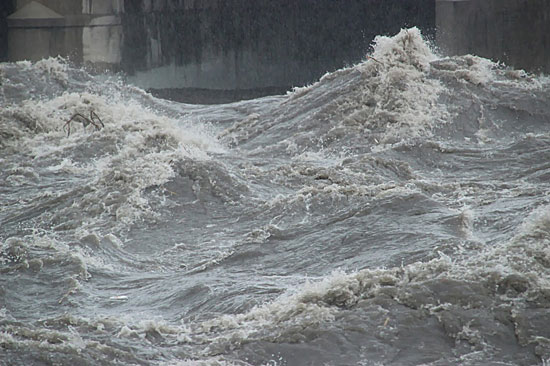
The L.A. River was swollen with last week’s downpour. Photo/Citifarmer
Here’s a factoid for those who think last week’s storms are water under the bridge now: Thanks to Los Angeles County’s flood control system, about $18 million worth of that rain is in the bank.
Los Angeles County Public Works Director Gail Farber reported this week that the county’s flood control infrastructure—sprawling, complex and generally taken for granted by Southern Californians—managed to collect and store some 18,000 acre-feet of rainfall by the time the skies cleared.
That’s enough water to supply 144,000 people for a year—roughly the population of Pasadena. Or, for Westsiders, a year’s worth of hydration for everyone in Santa Monica, the Pacific Palisades, Topanga Canyon and Malibu combined.
At about $1,000 per acre-foot for imported water, that’s good news, Farber told the Board of Supervisors on Tuesday. But in the midst of this drought, even more of that precious precipitation could have been saved had county dams not been clogged with dirt, sand and gravel from prior storms.
Instead, Farber said, water at Santa Anita Dam and Devil’s Gate Dam was released to maintain a safe capacity and prevent flooding.
“Had we more capacity behind our dams,” says Farber, “we could have captured more rain than we did.”
The storms dumped nearly a foot of rain last week on parts of Los Angeles County, raising water levels by as much as 36 feet at some of the county’s 14 dams. Though eagerly anticipated in this water-starved year, the rain also brought the threat of mudslides in foothill neighborhoods where brushfires have hit hard in recent months.
County workers had been out in force, working with surrounding municipalities and first responders to buttress vulnerable streets and help homeowners get ready, and were on hand round-the-clock as the storms hit.
Farber said the Department of Public Works alone “had more than 325 employees out there day and night, working 12-hour shifts in the pitch black with mud and debris flowing, and the rain coming down, and snow in the mountains, and hail sometimes.”
For all of that, the downpours scarcely made a dent in the three-year drought that has been withering the region, says Deputy DPW Director Massood Eftekhari.
“We’ve only accumulated 22 percent of what we normally accumulate, compared to prior years,” Eftekhari says. “We still have to conserve and collaborate to capture and utilize every drop we get.”
To that end, Public Works officials have been focused on maximizing the system’s capacity to better store rainwater when future storms hit. The county’s dams are set up not just to prevent rains from inundating neighborhoods in the flats and foothills, but also to collect storm water. That water later is released gradually onto massive spreading grounds where it percolates into the underground aquifers that supply about a third of L.A. County’s drinking water.
But each accumulation of rain also brings an accumulation of sediment and runoff. That sediment—hundreds of thousands of cubic yards of gunk in a typical year, enough to fill the Rose Bowl several times over—settles in dams and debris basins, and takes up space that otherwise would hold valuable rainfall.
Typically, that gunk gets trucked out over time by Public Works crews who dispose of it in designated “placement sites”, landfills and rock quarries—an epic task that, until recently, followed a time-honored schedule. After the historic 2009 Station Fire, however, so many tons of charred debris washed into the system that the county’s entire sediment management plan had to be recalculated, says Farber.
Now, she says, at least four county dams—Devil’s Gate, Big Tujunga, Pacoima and Cogswell—have been put on an accelerated sediment removal schedule. Devil’s Gate, which is near Pasadena, is first in line, with an environmental impact report already underway, and Pacoima will be soon to follow.
That intensified need to make room in the system has drawn some fire from neighborhoods near some of the dam sites. Though they have the most to lose should the clogged dams overflow, they also stand to suffer the greatest inconvenience from the truck traffic inherent in removing millions of cubic yards of muck.
As communities around the dams measure their risk against the potential for upheaval, the officials noted that the county will be working with state and federal agencies to come up with efficient ways to capture more storm water and prepare for future storms.
Meanwhile, they remind, this is no time to let our guard down.
“This was a good-sized gulp, but the drought still is not over,” Eftekhari says.
Devil’s Gate Dam is on an accelerated sediment removal schedule. Photo/LAT Community News
Posted 3/6/14






